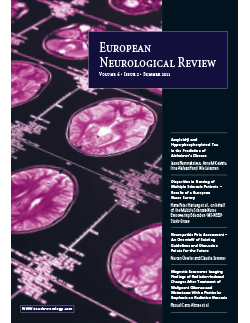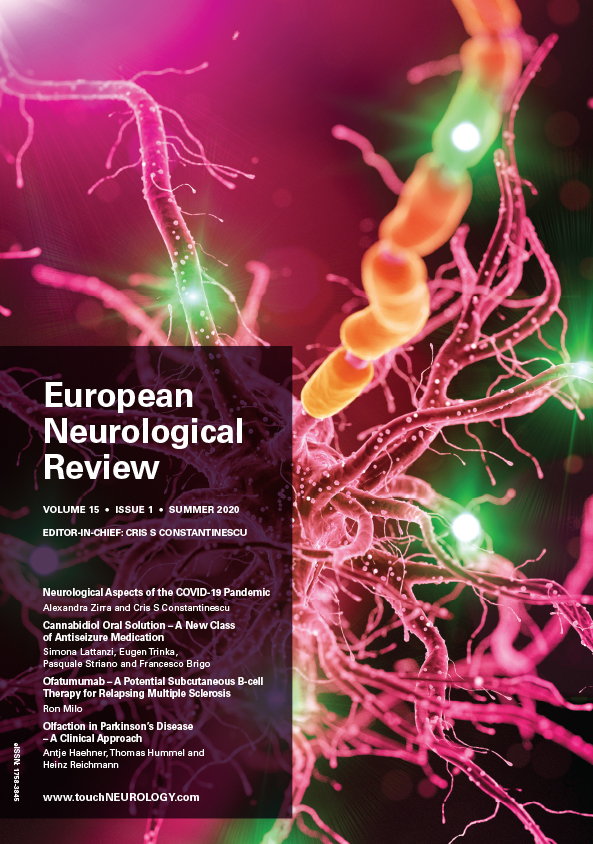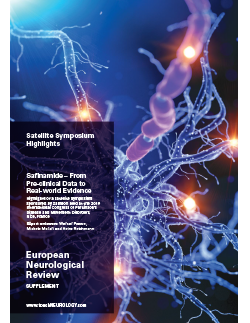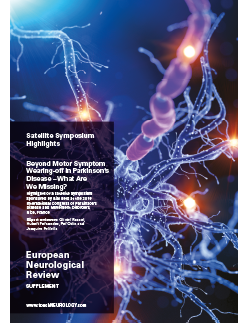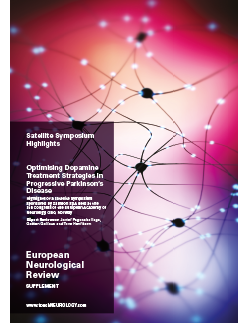EUROPEAN NEUROLOGICAL REVIEW – VOLUME 6 ISSUE 2 – SUMMER 2011
Foreword
Welcome to the latest edition of European Neurological Review. As usual, this edition covers a wide range of the neurological disorders that we, neurologists in Europe, see in our clinics on a daily basis and study in our research labs throughout our careers. The specific topics for this edition include the pathogenesis and prediction of […]
Neurodegenerative Disease
Neuropathological Findings of Alzheimer’s Disease
Alzheimer’s disease (AD) is the epitome of a progressive degenerative disease of the brain and culminates in dementia characterised in the beginning stages as a failure to retain new information for appropriate retrieval. As the underlying disease progresses, the patient experiences more profound memory loss and retrieval dysfunctions. These include not only the loss of […]
Brain Trauma
For decades, the primary approach and goal of therapy for stroke and neural injury have been the treatment of the injured tissue, with intervention designed to reduce the volume of cerebral infarction. Enormous effort has gone into the development of neuroprotective agents, including free radical scavengers,1–3 glutamate antagonists,4,5 among a myriad of others.6–8 Neuroprotective agents […]
Stroke is the third leading cause of death in the US, affecting approximately 795,000 patients annually.1 A recent analysis shows that only 3–5 % of acute stroke patients actually receive intravenous thrombolytic therapy.2 An important cause of non-treatment is the strict time criteria for acute medical and interventional therapies: many acute stroke patients are ineligible […]
Multiple Sclerosis
Multiple sclerosis (MS) is a chronic autoimmune disease resulting in demyelination and axonal loss in the central nervous system (CNS).1 This may lead to significant neurological deficits and physical disability including blurred vision, speech problems, loss of balance and coordination, pain and fatigue.1–3 According to the natural history of the disease, within 20 years of […]
Mobility impairment, particularly walking, is one of the most common and severely disabling consequences of multiple sclerosis (MS), and it has a profound, negative impact on the quality of life of many patients.1,2 Currently, >2 million people are estimated to suffer with MS worldwide,3 and as of 2005 an estimated 380,000 individuals out of 466 […]
Mobility impairment, particularly walking, is one of the most common and disruptive consequences of multiple sclerosis (MS) and can have a profound effect on independence, quality of life (QoL) and activities of daily living (ADL) for many patients.1–8 Impaired mobility results in a loss of work-related productivity,6,9–11 and is the single greatest economic burden of […]
Dystonia
Dystonia is characterised by involuntary muscle contractions causing twisting movements and abnormal postures.1 It is clinically and aetiologically heterogeneous and is most usefully classified by aetiology as either primary or secondary dystonia. In primary dystonias, dystonia is the only neurological sign (except for tremor), and there is no evidence of an acquired cause or of […]
Pain
Specifying the previous definition given by the International Association for the Study of Pain (IASP), neuropathic pain has recently been re-defined by the Neuropathic Pain Special Interest Group (NeuPSIG) as “pain arising as a direct consequence of a lesion or disease affecting the somatosensory system”.1 This re-definition eliminates the term ‘dysfunction’ from the IASP definition […]
Imaging
New contrast-enhancing lesions discovered on routine follow-up brain imaging at or near the site of previously treated primary or metastatic brain tumours represent a challenge for radiologists and oncologists, as radiation-induced injuries may have an appearance that is virtually indistinguishable from that of recurrent disease. With standard magnetic resonance imaging (MRI) modalities, a reliable distinction […]
What Is Constructive Interference in Steady State Imaging?

Trending Topic
Welcome to the latest edition of European Neurological Review, which features a wide range of articles of interest to neurologists and other practitioners involved in the care of patients with neurological illness. As we move into a new decade, the field of neurology continues to face fresh challenges. Despite an increased understanding of the pathophysiological […]
Journal Archive
European Neurological Review is a peer-reviewed, free-to-access, bi-annual neurology journal comprising review articles, case reports, practice guides, theoretical discussions, and original research. It features balanced and comprehensive articles written by leading authorities, addressing the most important and salient developments in the field of neurology in practical terms.
Latest articles videos and clinical updates - straight to your inbox
Log into your Touch Account
Earn and track your CME credits on the go, save articles for later, and follow the latest congress coverage.
Register now for FREE Access
Register for free to hear about the latest expert-led education, peer-reviewed articles, conference highlights, and innovative CME activities.
Sign up with an Email
Or use a Social Account.
This Functionality is for
Members Only
Explore the latest in medical education and stay current in your field. Create a free account to track your learning.


